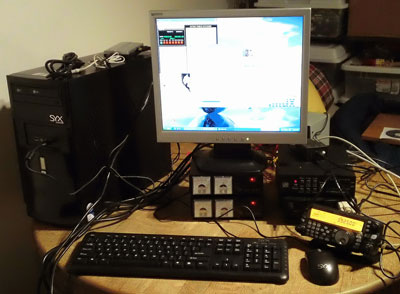 Handiham World for 23 February 2011
Handiham World for 23 February 2011
Welcome to Handiham World!

Last week was pretty busy and included a painful and inconvenient fall on the ice, so I was really late with the usual Technician Class audio lecture, which finally came out yesterday. We have only the final safety lecture to finish this week, then the Tech class is completed, aside from some possible review lectures. Lyle, K0LR, and I have been working on the remote base station. As we reported earlier, the W0ZSW remote went silent at Camp Courage when a router failed. The Echolink system continued to work, but the W4MQ remote control interface did not. I have been intending to put a new station into service anyway, and had done the preliminary setup at Camp Courage. The old TS-570 station did not support audio frequency announcements for our blind members, and the old computer was sometimes a bit sluggish. The new station features a Kenwood TS-480HX with the VGS1 voice chip and a Systemax computer from TigerDirect that is well-resourced and speedy. An LDG AT-200 Pro autotuner does the job of matching, and twin SEC 1235M switching supplies power the 200 Watt station. The rig to computer sound interface is a RIGblaster Nomic. Those of you who have compared the two Kenwood radios know that the HX model runs 200 watts but does not include the internal automatic antenna tuner. The HX mode l also requires a much larger power supply than does the 100 watt SAT model. In this case, we are using two switching power supplies, as is recommended in the manual. Only one of these supplies would have been required for the 100 watt radio. There definitely are some choices to make when deciding to buy one radio or the other. Operation and rig control through software is otherwise pretty much identical whether one uses the HX or the SAT models. Outside the shack, you have to make sure that your feedline, any baluns or other matching devices and accessories, and your antenna can all handle the higher power.
Lyle and I began putting the project together months ago, but it stalled after I did a preliminary setup on Nancy’s desk at Handiham headquarters. The idea was to set the new station equipment up in parallel to the old station, which would allow us to initially do testing with little or no interruption to the existing station. The problem was that I got really busy, making it difficult to devote time to testing the new station and getting the equipment to work the way we wanted. Every time I went to the office, something new would come up. The project sat and sat. Then a router failed at the main camp Internet distribution point. The station was inaccessible via the Internet, so we shut it down and I got serious about testing the new equipment, which I packed up and brought to our secret, undisclosed testing location. (Hint: It’s really close to my QTH.)
Last weekend proved to be pretty productive, and Lyle and I made some good progress. The station is now up and running during daylight hours (approximately 7:00 to 22:00 hours USA Central Time.) Users must visit the W0ZSW setup pages again and re-enter the IP address information for W0ZSW only. We would appreciate feedback from users. You will notice immediately upon connecting that the VGS1 voice module is now enabled and providing voice frequency readout. The antenna currently in use is a crummy Windom that doesn’t tune on all bands. Checking into PICONET on 3.925 MHz is pretty easy, though. Transmit is disabled on 160 m, where the antenna cannot tune. All of this will be fixed once the station is moved back to its regular location at Camp Courage when the router out there is replaced.
Remote base users who are already registered but who need a link to the W0ZSW setup pages may email me. (The links are available in the members section of the website.) Use of the stations is a member service that is not open to the public.
One other consideration: W0ZSW Echolink receive, which is open to any licensed amateur, is working intermittently due to a port forwarding issue. The W0EQO-L Echolink control is working well and should be used instead.
Oh, and be careful on the ice. The combination of a low coefficient of friction and gravity almost did me in, but I’m feeling great now, thank you very much. Spring can come anytime, though.
Patrick Tice, WA0TDA
Handiham System Manager
[email protected]













http://audacity.sourceforge.net/
I use this program all the time recording a host of things from 78/45/33 to tapes and ham radio inputs.
It’s a great program.
73,
Rick W3BI